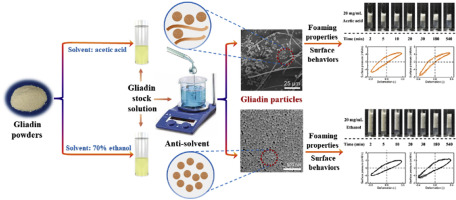当前位置:
X-MOL 学术
›
Food Hydrocoll.
›
论文详情
Our official English website, www.x-mol.net, welcomes your
feedback! (Note: you will need to create a separate account there.)
Foaming and surface rheological behaviors of gliadin particles: Effect of solvent and concentration of gliadin stock solution
Food Hydrocolloids ( IF 11.0 ) Pub Date : 2020-09-01 , DOI: 10.1016/j.foodhyd.2020.105868 Dengfeng Peng , Weiping Jin , Peiyuan Zhou , Cong Ren , Bin Li
Food Hydrocolloids ( IF 11.0 ) Pub Date : 2020-09-01 , DOI: 10.1016/j.foodhyd.2020.105868 Dengfeng Peng , Weiping Jin , Peiyuan Zhou , Cong Ren , Bin Li

|
Abstract The anti-solvent method was a green and facile approach to prepare water-insoluble proteins-based colloidal particles. The structure and functional properties of the resulting particles strongly depend on the preparation parameters of the anti-solvent process. Herein, two main parameters, solvent and concentration of protein stock solution, were chosen to investigate their effects on the structural, foaming, and surface rheological properties of gliadin particles. When the solvent was 70% ethanol solution (v/v), gliadin particles exhibited a uniform spherical structure. They could fast adsorb to the air/water interface and form a viscoelastic surface layer to prevent foam drainage, coalescence, and disproportionation, thus leading to impressive foamability (~250%) and high foam stability (~60 h) even the concentration of particles was very low (1.5 mg/mL). Besides, when the solvent was acetic acid, gliadin particles possessed spherical and wire-like hybrid structures. They had slower adsorption rate and weaker interaction at the interface when compared to the ethanol-based particles, resulting in poorer foam capacity and lower foam stability. The particles prepared by different solvents had evidently different nonlinear surface rheological responses. Besides, the concentration of gliadin stock solutions did not affect the foaming and surface behaviors of particles. The particle shape played a crucial role in affecting the foaming properties and surface behaviors of gliadin particles. Results imply that 70% ethanol aqueous solution is a good solvent for gliadin, which can endow strong foaming and surface rheological behaviors to gliadin particles.
中文翻译:

醇溶蛋白颗粒的起泡和表面流变行为:溶剂和醇溶蛋白原液浓度的影响
摘要 反溶剂法是制备水不溶性蛋白质胶体颗粒的一种绿色简便的方法。所得颗粒的结构和功能特性在很大程度上取决于反溶剂工艺的制备参数。在此,我们选择了两个主要参数,即蛋白质原液的溶剂和浓度,以研究它们对麦醇溶蛋白颗粒的结构、发泡和表面流变特性的影响。当溶剂为70%乙醇溶液(v/v)时,麦醇溶蛋白颗粒呈现均匀的球形结构。它们可以快速吸附到空气/水界面并形成粘弹性表面层,以防止泡沫排出、聚结和歧化,因此,即使颗粒浓度非常低 (1.5 mg/mL),也能产生令人印象深刻的起泡性 (~250%) 和高泡沫稳定性 (~60 h)。此外,当溶剂为乙酸时,麦醇溶蛋白颗粒具有球形和线状杂化结构。与乙醇基颗粒相比,它们的吸附速度较慢,界面处的相互作用较弱,导致泡沫容量和泡沫稳定性较差。不同溶剂制备的颗粒具有明显不同的非线性表面流变响应。此外,麦醇溶蛋白原液的浓度不影响颗粒的发泡和表面行为。颗粒形状在影响麦胶蛋白颗粒的发泡性能和表面行为方面起着至关重要的作用。结果表明,70%乙醇水溶液是麦胶的良好溶剂,
更新日期:2020-09-01
中文翻译:

醇溶蛋白颗粒的起泡和表面流变行为:溶剂和醇溶蛋白原液浓度的影响
摘要 反溶剂法是制备水不溶性蛋白质胶体颗粒的一种绿色简便的方法。所得颗粒的结构和功能特性在很大程度上取决于反溶剂工艺的制备参数。在此,我们选择了两个主要参数,即蛋白质原液的溶剂和浓度,以研究它们对麦醇溶蛋白颗粒的结构、发泡和表面流变特性的影响。当溶剂为70%乙醇溶液(v/v)时,麦醇溶蛋白颗粒呈现均匀的球形结构。它们可以快速吸附到空气/水界面并形成粘弹性表面层,以防止泡沫排出、聚结和歧化,因此,即使颗粒浓度非常低 (1.5 mg/mL),也能产生令人印象深刻的起泡性 (~250%) 和高泡沫稳定性 (~60 h)。此外,当溶剂为乙酸时,麦醇溶蛋白颗粒具有球形和线状杂化结构。与乙醇基颗粒相比,它们的吸附速度较慢,界面处的相互作用较弱,导致泡沫容量和泡沫稳定性较差。不同溶剂制备的颗粒具有明显不同的非线性表面流变响应。此外,麦醇溶蛋白原液的浓度不影响颗粒的发泡和表面行为。颗粒形状在影响麦胶蛋白颗粒的发泡性能和表面行为方面起着至关重要的作用。结果表明,70%乙醇水溶液是麦胶的良好溶剂,











































 京公网安备 11010802027423号
京公网安备 11010802027423号